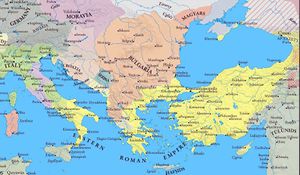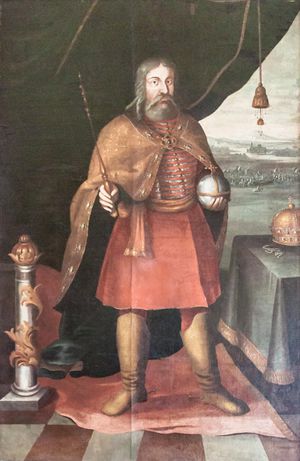What Are the Origins of the Kingdom of Hungary
Although geographically smaller and less populated than other European kingdoms, the Kingdom of Hungary played an extremely important role in the development of European history and geopolitics. During the Medieval Period, Hungary served as an important conduit between the Western and the Eastern/Orthodox European civilizations. Although the Hungarians joined the Roman Catholic Church after they converted to Christianity in the mid-tenth century and were therefore directly tied to the Western world, they maintained close ties to the Russians, Bulgarians, and Greeks of the Orthodox world. The Hungarians played a major role in the organization of the failed Fifth Crusade, and the Kingdom of Hungary served as a buffer zone for Western Europe from the Mongol and Ottoman invasions. The Kingdom of Hungary was also important in modern European geo-politics, comprising part of the Austro-Hungarian Empire and later being one of the Axis Powers in World War II.
The manner by which this small yet influential kingdom came to be was completely different than its European peers. The Kingdom of Hungary formed as the end result of the Magyar raids in the tenth century. The Magyars were nomadic raiders who settled in the Carpathian Basin and established a dynasty as they wrought destruction to both West and East Europe. Eventually, though, the Magyars became sedentary, accepted the culture of Europe, and became Europeans themselves, establishing the Kingdom of Hungary in the process.
Contents
The Magyar Invasions
In order to understand how the Kingdom of Hungary formed, it is important to understand the background of the medieval Hungarians, who were descended from the Magyar ethnic group. Unlike most Europeans, who are descended from Indo-European speaking cultural groups, the Magyars were part of the Finno-Ugaric cultural family. The Magyars’ language was specifically a form of Ugaric, which was part of the eastern branch of the family. The Magyars were most closely related to the Finns and various Siberian tribes, but they were separated from the main body of the Ugaric people in the first century BC. [1] Although the Magyars would later be known, and feared, for their martial prowess, they were driven from Siberia by Sabir tribe, never to return. [2] The Magyars wandered south until they ended up in the Eurasian steppe where they established themselves as fearsome nomadic warriors.
As the former Ugaric tribe wandered the steppe, raiding and living much as the Turkic nomads before them, they began to coalesce into the new ethnic group known as the Magyars. The origins of the term “Magyar” are somewhat varied and refer to different aspects of their culture. Magyar referred to one of the group’s forefathers, was a toponym for their steppe homeland, and was also probably related to the word Merger, which was one of the seven original tribes that merged to form a single group before entering Europe. [3]
In both Western and Orthodox historical sources, the Magyars were known by a number of different terms. Because the Magyars fought and lived much like the Turkic people of the steppe at the time, Byzantine histories of the tenth century referred to them as “Turks.” Later Byzantine sources called them “Dacians,” while Western chronicles would sometimes refer to the Magyars as “Wallachians.” This somewhat confusing nomenclature was compounded by the term for the Magyars’ eventual home, Hungary. Although there is a commonly held belief that the term “Hungary” comes from the Huns, who used the Carpathian Basin as their headquarters in the fifth and sixth centuries AD, the word is actually derived from the Old Slavonic word Ongri. The Slavs referred to the land of the Carpathian Basin and latter the Magyars as Ongri, which later became “Hungary” in Latin. [4]
Since the Magyars were not a literate people until the tenth century, the construction of their early history before their arrival in the Carpathian Basin is based on archaeology and other sources. According to the Byzantine Emperor Constantine VII (ruled 908-913), who wrote a history of his times, the Magyars were seven tribes that were led by a man named Lebedias and were aligned with the Turkic Khazars.
“The Turks were seven clans, and they had never had over them a prince either native or foreign, but there were among them ‘voivodes’, of whom first voivode was the aforesaid Lebedias. They lived together with the Chazars for three years, and fought in alliance with the Chazars in all their wars. [5]
By the late ninth century the different Magyar tribes, and the Khazars who were with them, were for the most part indistinguishable. [6] They were by that point a large horde of Magyars that worked as a collective to raid and conquer all in their path.
The Magyar invasions were precipitated by a process common in numerous eras throughout world history. As menacing as the Magyars may have been, they were the victim of the even more destructive Pechneg nomadic tribe, which pushed the Magyars into the Carpathian Basin in 894. [7] The Magyar’s early European raids were a bit circumspect, as the able Moravian king Svatopluk I (ruled 885-894) was able to hold back the tide, but after he died his dynasty fell into chaos and collapsed in 905. The Magyars then conducted extensive raids until 955 when they were stopped by the Holy Roman Emperor, Otto I (reigned 936-973). Up until that point, none of the kingdoms of Europe had been very successful in dealing with the Magyars’ tactics. Like the Vikings who were also raiding Europe at the same time, the Magyars conducted quick strikes on relatively unguarded churches, monasteries, and villages. Since the Magyars were a nomadic group from the steppe, they lived on horseback, which gave them their advantages of mobility and speed. When they faced a more heavily armed and armored foe, the Magyars would feign a retreat on horseback and then turn and rein arrows down on their enemies.
When Otto and his German allies met the massive Magyar horde at the Battle of Lechfeld near Augsburg on August 10, 955, he took the nomadic horde’s tactics into account. Although the Germans were heavily outnumbered, they had the advantage of better armor, so he ordered his army to quickly engage the Magyars. The Magyars attempted to flank the Germans, but were unable to do so and they also could not get enough separation to do their famed feigned retreat. The Magyar horde was utterly devastated, which meant that the survivors back in Hungary had to rethink their long term geopolitical policies. [8]
The Arpad Dynasty
Even before the Magyars were defeated at Lechfeld, they were making notable steps to integrate themselves into the greater European community. They had begun making diplomatic ties with dynasties in both West and East Europe and had established their own royal dynasty. The first king of Hungary is generally thought to have been a man named Arpad (ruled 895-907). Arpad was the son of Almos, and according to Constantine VII he was elected king of the Magyars at the urging of their Khazar allies.
“There is a voivode other than me, called Almoutzis or his son Arpad, be made prince, and be obedient to your word.” That chagan was pleased at this saying, and gave some of this met to go with him, and sent them to the Turks, and after they had talked the matter over with the Turks, the Turks preferred that Arpad should be prince rather than Almoutzis his father, for he was of superior parts and greatly admired for wisdom and counsel and valour, and capable of this rule; and so they made him prince according to the custom, or ‘zakanon’, of the Chazars, by lifting him upon a shield. Before this Arpad the Turks had never at any time had any other prince, and so even to this day the prince of Turkey is from his family.” [9]
The title Arpad held was “Grand Prince of the Hungarians/Magyars,” not King of Hungary. He would be succeeded by Zoltan (c. 907-950), Taskony (c. 950-?), and Prince Geza (972-997). Geza’s rule was the period when the Magyars transitioned from brutal nomadic warriors to a sedentary kingdom and a member of the European community. Geza promoted Christianity and began organizing the Church in Hungary in a way that made it much easier for his successors to integrate Hungary into Europe and also to gain acceptance with the monarchs of Western Europe. After cultivating relations with the Church, Geza offered his son in marriage to Henry II of Bavaria’s daughter and sent envoys to Otto I renouncing all Magyar claims on German lands. [10]
The Rule of St. Stephen
Stephen I was the first Magyar monarch to take the title “King of Hungary” and is today viewed by Hungarians as the patron saint of their country. Stephen brutally repressed all opposition within his kingdom and expanded his predecessors’ policies of diplomatic marriages and alliances with other European monarchs. He continued to foster good relations with the Holy Roman Empire and other German kingdoms, but also made diplomatic inroads with Hungary’s Orthodox neighbors. Stephen aided Basil II of Byzantium (ruled 976-1025) against the Bulgars[11] and made peace with the powerful Rus’ principalities, namely Valdimir the Grand Prince of Kiev (reigned 980-1015).
“For Vladimir was fond of his followers, and consulted them concerning matters of administration, wars, and government. He lived at peace with neighboring Princes, Boleslav of Poland, Stephen of Hungary, and Udalrich of Bohemia, and there was amity and friendship among them.” [12]
Perhaps most important, Stephen continued his predecessor’s policy of building the Church hierarchy in Hungary. Stephen had German, Italian, and French priests imported to Hungary to help in his project and to minister to the peasantry, many of whom were still pagans during his rule. Eventually ten dioceses and two archbishoprics of the Catholic Church were founded during Stephen’s rule, which along with his aggressive anti-pagan laws helped ensure that Hungary would become a Catholic kingdom. [13]
Conclusion
The later Arpad Dynasty was consumed with internal conflict and was victim of the Mongol invasion of 1241, which led to the termination of the dynasty in 1301; but the political foundations the Arpad kings put in place persisted until World War II. The Kingdom of Hungary began as little more than a warrior coalition of Magyar nomads, but over the course of the tenth century it evolved into a legitimate European dynasty. The early Arpad princes and kings laid the foundations of the Hungarian state by cultivating good relations with their powerful Western and Orthodox neighbors and by becoming active members of the Roman Catholic Church. The Magyars’ brutality helped them win their land, yet it was their political acumen that mad them members of the European community.
References
- ↑ Engel, Pál. The Realm of St. Stephen: A History of Medieval Hungary. Translated by Tamás Pálosfalvi. Edited by Andrew Ayton. (London: I. B. Tauris, 2015), p. 9
- ↑ György, György. “Dual Kingship and the Seven Chieftains of the Hungarians in the Era of the Conquest and the Raids.” Acta Orientalia Academiae Scientiarium Hungaricae 47 (1994) p. 87
- ↑ Szabados, György. “Magyar – A Name for Persons, Places, Communities.” Hungarian Historical Review 7 (2018) p. 82
- ↑ Engel, p. 6
- ↑ Porphyrogenitus, Constantine De Administrando Imperio. Edited by Gyula Moravcsik. Translated by Romilly J. H. Jenkins. Revised Edition. (Washington: Dumbarton Oaks Center for Byzantine Studies, 2016), XXXVIII, 171
- ↑ Engel, p. 22
- ↑ Engle, pgs. 11-12
- ↑ Leyser, Karl. “The Battle of Lech, 955: A Study in Tenth-century Warfare.” History 50 (1965) pgs. 11-20
- ↑ Constantine Porphyrogenitus, XXXVIII, 173
- ↑ Engel, pgs. 25-26
- ↑ Engel, p. 28
- ↑ Cross, Samuel Hazzard, and Olgerd P. Serbowitz-Wetzor, eds, and trans. The Russian Primary Chronicle: Laurentian Text. (Cambridge, Massachusetts: The Mediaeval Academy of America, 2012), p. 122
- ↑ Engel, pgs. 42-45



